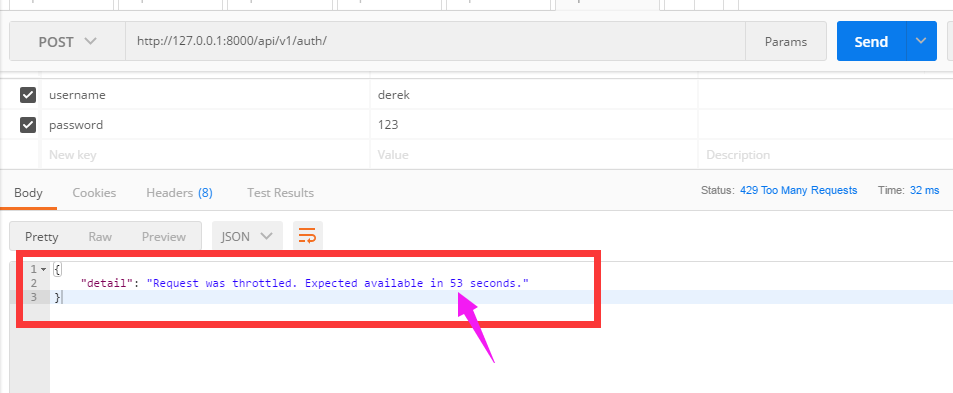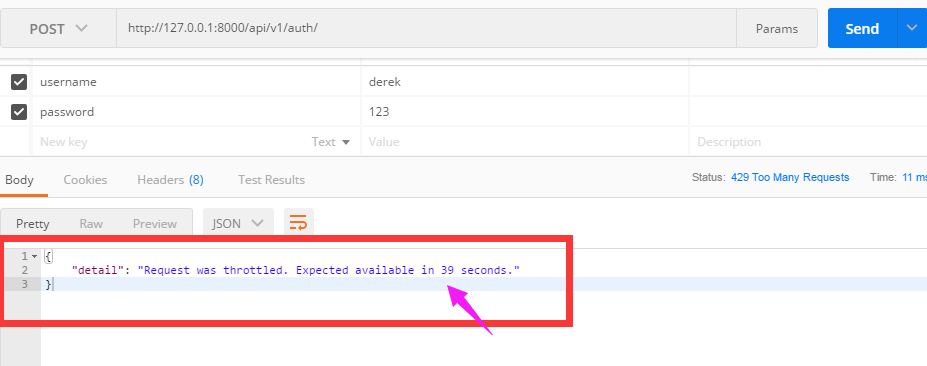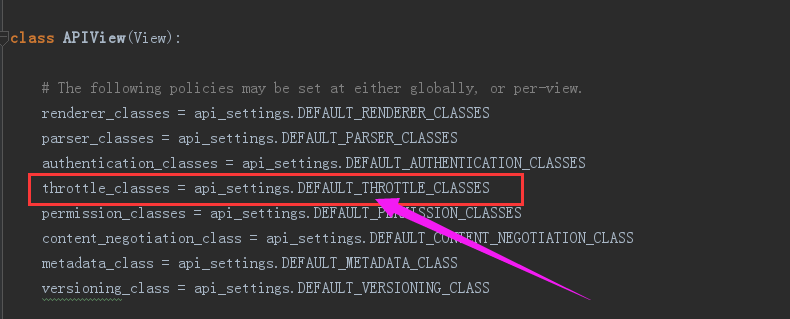一 添加节流
自定义节流的方法
- 限制60s内只能访问3次
(1)API文件夹下面新建throttle.py,代码如下:
# utils/throttle.py
from rest_framework.throttling import BaseThrottle
import time
VISIT_RECORD = {} #保存访问记录
class VisitThrottle(BaseThrottle):
'''60s内只能访问3次'''
def __init__(self):
self.history = None #初始化访问记录
def allow_request(self,request,view):
#获取用户ip (get_ident)
remote_addr = self.get_ident(request)
ctime = time.time()
#如果当前IP不在访问记录里面,就添加到记录
if remote_addr not in VISIT_RECORD:
VISIT_RECORD[remote_addr] = [ctime,] #键值对的形式保存
return True #True表示可以访问
#获取当前ip的历史访问记录
history = VISIT_RECORD.get(remote_addr)
#初始化访问记录
self.history = history
#如果有历史访问记录,并且最早一次的访问记录离当前时间超过60s,就删除最早的那个访问记录,
#只要为True,就一直循环删除最早的一次访问记录
while history and history[-1] < ctime - 60:
history.pop()
#如果访问记录不超过三次,就把当前的访问记录插到第一个位置(pop删除最后一个)
if len(history) < 3:
history.insert(0,ctime)
return True
def wait(self):
'''还需要等多久才能访问'''
ctime = time.time()
return 60 - (ctime - self.history[-1])
(2)settings中全局配置节流
#全局
REST_FRAMEWORK = {
#节流
"DEFAULT_THROTTLE_CLASSES":['API.utils.throttle.VisitThrottle'],
}
(3)现在访问auth看看结果:
- 60s内访问次数超过三次,会限制访问
- 提示剩余多少时间可以访问

接着访问

二 节流源码分析
(1)dispatch
def dispatch(self, request, *args, **kwargs):
"""
`.dispatch()` is pretty much the same as Django's regular dispatch,
but with extra hooks for startup, finalize, and exception handling.
"""
self.args = args
self.kwargs = kwargs
#对原始request进行加工,丰富了一些功能
#Request(
# request,
# parsers=self.get_parsers(),
# authenticators=self.get_authenticators(),
# negotiator=self.get_content_negotiator(),
# parser_context=parser_context
# )
#request(原始request,[BasicAuthentications对象,])
#获取原生request,request._request
#获取认证类的对象,request.authticators
#1.封装request
request = self.initialize_request(request, *args, **kwargs)
self.request = request
self.headers = self.default_response_headers # deprecate?
try:
#2.认证
self.initial(request, *args, **kwargs)
# Get the appropriate handler method
if request.method.lower() in self.http_method_names:
handler = getattr(self, request.method.lower(),
self.http_method_not_allowed)
else:
handler = self.http_method_not_allowed
response = handler(request, *args, **kwargs)
except Exception as exc:
response = self.handle_exception(exc)
self.response = self.finalize_response(request, response, *args, **kwargs)
return self.response
(2)initial
def initial(self, request, *args, **kwargs):
"""
Runs anything that needs to occur prior to calling the method handler.
"""
self.format_kwarg = self.get_format_suffix(**kwargs)
# Perform content negotiation and store the accepted info on the request
neg = self.perform_content_negotiation(request)
request.accepted_renderer, request.accepted_media_type = neg
# Determine the API version, if versioning is in use.
version, scheme = self.determine_version(request, *args, **kwargs)
request.version, request.versioning_scheme = version, scheme
# Ensure that the incoming request is permitted
#4.实现认证
self.perform_authentication(request)
#5.权限判断
self.check_permissions(request)
#6.控制访问频率
self.check_throttles(request)
(3)check_throttles
里面有个allow_request
def check_throttles(self, request):
"""
Check if request should be throttled.
Raises an appropriate exception if the request is throttled.
"""
for throttle in self.get_throttles():
if not throttle.allow_request(request, self):
self.throttled(request, throttle.wait())
(4)get_throttles
def get_throttles(self):
"""
Instantiates and returns the list of throttles that this view uses.
"""
return [throttle() for throttle in self.throttle_classes]
(5)thtottle_classes

三 内置节流类
上面是写的自定义节流,drf内置了很多节流的类,用起来比较方便。
(1)BaseThrottle
- 自己要写allow_request和wait方法
- get_ident就是获取ip
class BaseThrottle(object):
"""
Rate throttling of requests.
"""
def allow_request(self, request, view):
"""
Return `True` if the request should be allowed, `False` otherwise.
"""
raise NotImplementedError('.allow_request() must be overridden')
def get_ident(self, request):
"""
Identify the machine making the request by parsing HTTP_X_FORWARDED_FOR
if present and number of proxies is > 0. If not use all of
HTTP_X_FORWARDED_FOR if it is available, if not use REMOTE_ADDR.
"""
xff = request.META.get('HTTP_X_FORWARDED_FOR')
remote_addr = request.META.get('REMOTE_ADDR')
num_proxies = api_settings.NUM_PROXIES
if num_proxies is not None:
if num_proxies == 0 or xff is None:
return remote_addr
addrs = xff.split(',')
client_addr = addrs[-min(num_proxies, len(addrs))]
return client_addr.strip()
return ''.join(xff.split()) if xff else remote_addr
def wait(self):
"""
Optionally, return a recommended number of seconds to wait before
the next request.
"""
return None
(2)SimpleRateThrottle
class SimpleRateThrottle(BaseThrottle):
"""
A simple cache implementation, that only requires `.get_cache_key()`
to be overridden.
The rate (requests / seconds) is set by a `rate` attribute on the View
class. The attribute is a string of the form 'number_of_requests/period'.
Period should be one of: ('s', 'sec', 'm', 'min', 'h', 'hour', 'd', 'day')
Previous request information used for throttling is stored in the cache.
"""
cache = default_cache
timer = time.time
cache_format = 'throttle_%(scope)s_%(ident)s'
scope = None #这个值自定义,写什么都可以
THROTTLE_RATES = api_settings.DEFAULT_THROTTLE_RATES
def __init__(self):
if not getattr(self, 'rate', None):
self.rate = self.get_rate()
self.num_requests, self.duration = self.parse_rate(self.rate)
def get_cache_key(self, request, view):
"""
Should return a unique cache-key which can be used for throttling.
Must be overridden.
May return `None` if the request should not be throttled.
"""
raise NotImplementedError('.get_cache_key() must be overridden')
def get_rate(self):
"""
Determine the string representation of the allowed request rate.
"""
if not getattr(self, 'scope', None):
msg = ("You must set either `.scope` or `.rate` for '%s' throttle" %
self.__class__.__name__)
raise ImproperlyConfigured(msg)
try:
return self.THROTTLE_RATES[self.scope]
except KeyError:
msg = "No default throttle rate set for '%s' scope" % self.scope
raise ImproperlyConfigured(msg)
def parse_rate(self, rate):
"""
Given the request rate string, return a two tuple of:
<allowed number of requests>, <period of time in seconds>
"""
if rate is None:
return (None, None)
num, period = rate.split('/')
num_requests = int(num)
duration = {'s': 1, 'm': 60, 'h': 3600, 'd': 86400}[period[0]]
return (num_requests, duration)
def allow_request(self, request, view):
"""
Implement the check to see if the request should be throttled.
On success calls `throttle_success`.
On failure calls `throttle_failure`.
"""
if self.rate is None:
return True
self.key = self.get_cache_key(request, view)
if self.key is None:
return True
self.history = self.cache.get(self.key, [])
self.now = self.timer()
# Drop any requests from the history which have now passed the
# throttle duration
while self.history and self.history[-1] <= self.now - self.duration:
self.history.pop()
if len(self.history) >= self.num_requests:
return self.throttle_failure()
return self.throttle_success()
def throttle_success(self):
"""
Inserts the current request's timestamp along with the key
into the cache.
"""
self.history.insert(0, self.now)
self.cache.set(self.key, self.history, self.duration)
return True
def throttle_failure(self):
"""
Called when a request to the API has failed due to throttling.
"""
return False
def wait(self):
"""
Returns the recommended next request time in seconds.
"""
if self.history:
remaining_duration = self.duration - (self.now - self.history[-1])
else:
remaining_duration = self.duration
available_requests = self.num_requests - len(self.history) + 1
if available_requests <= 0:
return None
return remaining_duration / float(available_requests)
我们可以通过继承SimpleRateThrottle类,来实现节流,会更加的简单,因为SimpleRateThrottle里面都帮我们写好了
(1)throttle.py
from rest_framework.throttling import SimpleRateThrottle
class VisitThrottle(SimpleRateThrottle):
'''匿名用户60s只能访问三次(根据ip)'''
scope = 'NBA' #这里面的值,自己随便定义,settings里面根据这个值配置Rate
def get_cache_key(self, request, view):
#通过ip限制节流
return self.get_ident(request)
class UserThrottle(SimpleRateThrottle):
'''登录用户60s可以访问10次'''
scope = 'NBAUser' #这里面的值,自己随便定义,settings里面根据这个值配置Rate
def get_cache_key(self, request, view):
return request.user.username
(2)settings.py
#全局
REST_FRAMEWORK = {
#节流
"DEFAULT_THROTTLE_CLASSES":['API.utils.throttle.UserThrottle'], #全局配置,登录用户节流限制(10/m)
"DEFAULT_THROTTLE_RATES":{
'NBA':'3/m', #没登录用户3/m,NBA就是scope定义的值
'NBAUser':'10/m', #登录用户10/m,NBAUser就是scope定义的值
}
}
(3)views.py
局部配置方法
class AuthView(APIView):
.
.
.
# 默认的节流是登录用户(10/m),AuthView不需要登录,这里用匿名用户的节流(3/m)
throttle_classes = [VisitThrottle,]
.
.

from django.shortcuts import render,HttpResponse from django.http import JsonResponse from rest_framework.views import APIView from API import models from rest_framework.request import Request from rest_framework import exceptions from rest_framework.authentication import BaseAuthentication from API.utils.permission import SVIPPremission,MyPremission from API.utils.throttle import VisitThrottle ORDER_DICT = { 1:{ 'name':'apple', 'price':15 }, 2:{ 'name':'dog', 'price':100 } } def md5(user): import hashlib import time #当前时间,相当于生成一个随机的字符串 ctime = str(time.time()) m = hashlib.md5(bytes(user,encoding='utf-8')) m.update(bytes(ctime,encoding='utf-8')) return m.hexdigest() class AuthView(APIView): '''用于用户登录验证''' authentication_classes = [] #里面为空,代表不需要认证 permission_classes = [] #不里面为空,代表不需要权限 # 默认的节流是登录用户(10/m),AuthView不需要登录,这里用匿名用户的节流(3/m) throttle_classes = [VisitThrottle,] def post(self,request,*args,**kwargs): ret = {'code':1000,'msg':None} try: user = request._request.POST.get('username') pwd = request._request.POST.get('password') obj = models.UserInfo.objects.filter(username=user,password=pwd).first() if not obj: ret['code'] = 1001 ret['msg'] = '用户名或密码错误' #为用户创建token token = md5(user) #存在就更新,不存在就创建 models.UserToken.objects.update_or_create(user=obj,defaults={'token':token}) ret['token'] = token except Exception as e: ret['code'] = 1002 ret['msg'] = '请求异常' return JsonResponse(ret) class OrderView(APIView): ''' 订单相关业务(只有SVIP用户才能看) ''' def get(self,request,*args,**kwargs): self.dispatch #request.user #request.auth ret = {'code':1000,'msg':None,'data':None} try: ret['data'] = ORDER_DICT except Exception as e: pass return JsonResponse(ret) class UserInfoView(APIView): ''' 订单相关业务(普通用户和VIP用户可以看) ''' permission_classes = [MyPremission,] #不用全局的权限配置的话,这里就要写自己的局部权限 def get(self,request,*args,**kwargs): print(request.user) return HttpResponse('用户信息') views.py
说明:
- API.utils.throttle.UserThrottle 这个是全局配置(根据ip限制,10/m)
- DEFAULT_THROTTLE_RATES --->>>设置访问频率的
- throttle_classes = [VisitThrottle,] --->>>局部配置(不适用settings里面默认的全局配置)
总结
基本使用
- 创建类,继承BaseThrottle, 实现:allow_request ,wait
- 创建类,继承SimpleRateThrottle, 实现: get_cache_key, scope='NBA' (配置文件中的key)
全局
#节流
"DEFAULT_THROTTLE_CLASSES":['API.utils.throttle.UserThrottle'], #全局配置,登录用户节流限制(10/m)
"DEFAULT_THROTTLE_RATES":{
'NBA':'3/m', #没登录用户3/m,NBA就是scope定义的值
'NBAUser':'10/m', #登录用户10/m,NBAUser就是scope定义的值
}
}
局部
throttle_classes = [VisitThrottle,]
所有代码
认证、权限和节流

# MyProject/urls.py from django.contrib import admin from django.urls import path from API.views import AuthView,OrderView,UserInfoView urlpatterns = [ path('admin/', admin.site.urls), path('api/v1/auth/',AuthView.as_view()), path('api/v1/order/',OrderView.as_view()), path('api/v1/info/',UserInfoView.as_view()), ]

#全局 REST_FRAMEWORK = { #认证 "DEFAULT_AUTHENTICATION_CLASSES":['API.utils.auth.Authentication',], #权限 "DEFAULT_PERMISSION_CLASSES":['API.utils.permission.SVIPPermission'], #节流 "DEFAULT_THROTTLE_CLASSES":['API.utils.throttle.UserThrottle'], #全局配置,登录用户节流限制(10/m) "DEFAULT_THROTTLE_RATES":{ 'NBA':'3/m', #没登录用户3/m,NBA就是scope定义的值 'NBAUser':'10/m', #登录用户10/m,NBAUser就是scope定义的值 } }

# API/models.py from django.db import models class UserInfo(models.Model): USER_TYPE = ( (1,'普通用户'), (2,'VIP'), (3,'SVIP') ) user_type = models.IntegerField(choices=USER_TYPE) username = models.CharField(max_length=32) password = models.CharField(max_length=64) class UserToken(models.Model): user = models.OneToOneField(UserInfo,on_delete=models.CASCADE) token = models.CharField(max_length=64)

# API/views.py from django.shortcuts import render,HttpResponse from django.http import JsonResponse from rest_framework.views import APIView from API import models from rest_framework.request import Request from rest_framework import exceptions from rest_framework.authentication import BaseAuthentication from API.utils.permission import SVIPPermission,MyPermission from API.utils.throttle import VisitThrottle ORDER_DICT = { 1:{ 'name':'apple', 'price':15 }, 2:{ 'name':'dog', 'price':100 } } def md5(user): import hashlib import time #当前时间,相当于生成一个随机的字符串 ctime = str(time.time()) m = hashlib.md5(bytes(user,encoding='utf-8')) m.update(bytes(ctime,encoding='utf-8')) return m.hexdigest() class AuthView(APIView): '''用于用户登录验证''' authentication_classes = [] #里面为空,代表不需要认证 permission_classes = [] #不里面为空,代表不需要权限 # 默认的节流是登录用户(10/m),AuthView不需要登录,这里用匿名用户的节流(3/m) throttle_classes = [VisitThrottle,] def post(self,request,*args,**kwargs): ret = {'code':1000,'msg':None} try: user = request._request.POST.get('username') pwd = request._request.POST.get('password') obj = models.UserInfo.objects.filter(username=user,password=pwd).first() if not obj: ret['code'] = 1001 ret['msg'] = '用户名或密码错误' #为用户创建token token = md5(user) #存在就更新,不存在就创建 models.UserToken.objects.update_or_create(user=obj,defaults={'token':token}) ret['token'] = token except Exception as e: ret['code'] = 1002 ret['msg'] = '请求异常' return JsonResponse(ret) class OrderView(APIView): ''' 订单相关业务(只有SVIP用户才能看) ''' def get(self,request,*args,**kwargs): self.dispatch #request.user #request.auth ret = {'code':1000,'msg':None,'data':None} try: ret['data'] = ORDER_DICT except Exception as e: pass return JsonResponse(ret) class UserInfoView(APIView): ''' 订单相关业务(普通用户和VIP用户可以看) ''' permission_classes = [MyPermission,] #不用全局的权限配置的话,这里就要写自己的局部权限 def get(self,request,*args,**kwargs): print(request.user) return HttpResponse('用户信息')

# API/utils/auth/py from rest_framework import exceptions from API import models from rest_framework.authentication import BaseAuthentication class Authentication(BaseAuthentication): '''用于用户登录验证''' def authenticate(self,request): token = request._request.GET.get('token') token_obj = models.UserToken.objects.filter(token=token).first() if not token_obj: raise exceptions.AuthenticationFailed('用户认证失败') #在rest framework内部会将这两个字段赋值给request,以供后续操作使用 return (token_obj.user,token_obj) def authenticate_header(self, request): pass

# utils/permission.py from rest_framework.permissions import BasePermission class SVIPPermission(BasePermission): message = "必须是SVIP才能访问" def has_permission(self,request,view): if request.user.user_type != 3: return False return True class MyPermission(BasePermission): def has_permission(self,request,view): if request.user.user_type == 3: return False return True

# utils/throttle.py # # from rest_framework.throttling import BaseThrottle # import time # VISIT_RECORD = {} #保存访问记录 # # class VisitThrottle(BaseThrottle): # '''60s内只能访问3次''' # def __init__(self): # self.history = None #初始化访问记录 # # def allow_request(self,request,view): # #获取用户ip (get_ident) # remote_addr = self.get_ident(request) # ctime = time.time() # #如果当前IP不在访问记录里面,就添加到记录 # if remote_addr not in VISIT_RECORD: # VISIT_RECORD[remote_addr] = [ctime,] #键值对的形式保存 # return True #True表示可以访问 # #获取当前ip的历史访问记录 # history = VISIT_RECORD.get(remote_addr) # #初始化访问记录 # self.history = history # # #如果有历史访问记录,并且最早一次的访问记录离当前时间超过60s,就删除最早的那个访问记录, # #只要为True,就一直循环删除最早的一次访问记录 # while history and history[-1] < ctime - 60: # history.pop() # #如果访问记录不超过三次,就把当前的访问记录插到第一个位置(pop删除最后一个) # if len(history) < 3: # history.insert(0,ctime) # return True # # def wait(self): # '''还需要等多久才能访问''' # ctime = time.time() # return 60 - (ctime - self.history[-1]) from rest_framework.throttling import SimpleRateThrottle class VisitThrottle(SimpleRateThrottle): '''匿名用户60s只能访问三次(根据ip)''' scope = 'NBA' #这里面的值,自己随便定义,settings里面根据这个值配置Rate def get_cache_key(self, request, view): #通过ip限制节流 return self.get_ident(request) class UserThrottle(SimpleRateThrottle): '''登录用户60s可以访问10次''' scope = 'NBAUser' #这里面的值,自己随便定义,settings里面根据这个值配置Rate def get_cache_key(self, request, view): return request.user.username
